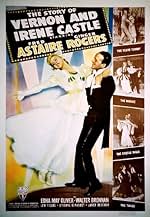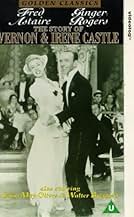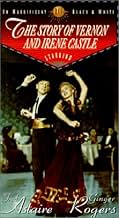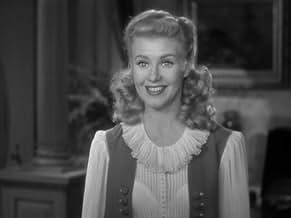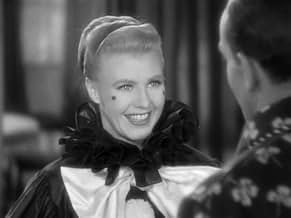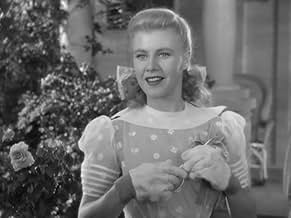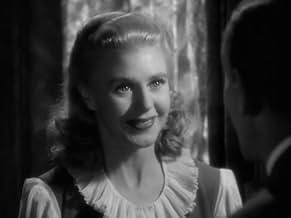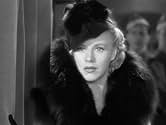La vida de Irene y Vernon Castle
Título original: The Story of Vernon and Irene Castle
CALIFICACIÓN DE IMDb
6.9/10
2.9 k
TU CALIFICACIÓN
La historia del matrimonio de Irene y Vernon Castle, sensacionales bailarines de salón antes de la Primera Guerra Mundial.La historia del matrimonio de Irene y Vernon Castle, sensacionales bailarines de salón antes de la Primera Guerra Mundial.La historia del matrimonio de Irene y Vernon Castle, sensacionales bailarines de salón antes de la Primera Guerra Mundial.
- Dirección
- Guionistas
- Elenco
- Premios
- 4 premios ganados y 1 nominación en total
Buzz Barton
- Undetermined Secondary Role
- (sin créditos)
Max Barwyn
- Waiter - Cafe de Paris
- (sin créditos)
Opiniones destacadas
"Castles in the Air" is the title of Irene's 1958 autobiography but it's also an apt summarization of this robust, poignant tale. Vernon and Irene Castle were far more famous and influential in their day than Fred Astaire or Ginger Rogers were later, though they are less remembered now.
This movie pays glorious tribute to the Castles and their dance repertoire which Astaire and Rogers beautifully replicate. The crazy maze of fame that swirled around the young couple, their great love for each other and their private travail, are sensitively presented. The supporting cast includes the always superb Walter Brennan as the Castles' chaperone-servant, and Edna May Oliver as their agent, a take-off on real-life Elisabeth (Bessy) Marbury. Producer Lew Fields, who gave Vernon Castle his first job on the New York stage, makes a cameo appearance.
Although Irene Castle served as technical advisor and assisted Walter Plunkett with costuming, there were polite clashes on the set (and off) between her and Ginger Rogers who objected, most notably, to Irene's insistence that she dye her hair dark and cut it short to more accurately resemble her. For those familiar with Irene Castle, whose extraordinary looks (particularly the bobbed hair-style she introduced) were so much a part of her image, they will understand Irene's dissatisfaction with long-tressed, blonde Rogers. It says much for Ginger Rogers' capabilities that the story is not hindered by this departure from authenticity (more glaring then than today).
A NOTE ON COSTUMES:
This film gives some idea of Irene's popularity as a fashion trendsetter which was tremendous in the 1910s and 20s. In fact, many of the stunning gowns Ginger Rogers wears are quite faithful adaptations of costumes designed by Lucile (Lady Duff-Gordon) for Irene Castle during her Broadway and silent-movie days. Ginger's dress with the handkerchief hem and huge chiffon sleeves (double-banded in fur) was copied from the original which Irene wore for the premiere of Irving Berlin's "Watch Your Step" in 1914. This original, by Lucile, is now at the Costume Institute of the Metropolitan Museum of Art. A black and white evening gown, a pleated silk day dress, and a striped travelling suit are other Lucile designs reproduced by Plunkett for Rogers in this picture.
This movie pays glorious tribute to the Castles and their dance repertoire which Astaire and Rogers beautifully replicate. The crazy maze of fame that swirled around the young couple, their great love for each other and their private travail, are sensitively presented. The supporting cast includes the always superb Walter Brennan as the Castles' chaperone-servant, and Edna May Oliver as their agent, a take-off on real-life Elisabeth (Bessy) Marbury. Producer Lew Fields, who gave Vernon Castle his first job on the New York stage, makes a cameo appearance.
Although Irene Castle served as technical advisor and assisted Walter Plunkett with costuming, there were polite clashes on the set (and off) between her and Ginger Rogers who objected, most notably, to Irene's insistence that she dye her hair dark and cut it short to more accurately resemble her. For those familiar with Irene Castle, whose extraordinary looks (particularly the bobbed hair-style she introduced) were so much a part of her image, they will understand Irene's dissatisfaction with long-tressed, blonde Rogers. It says much for Ginger Rogers' capabilities that the story is not hindered by this departure from authenticity (more glaring then than today).
A NOTE ON COSTUMES:
This film gives some idea of Irene's popularity as a fashion trendsetter which was tremendous in the 1910s and 20s. In fact, many of the stunning gowns Ginger Rogers wears are quite faithful adaptations of costumes designed by Lucile (Lady Duff-Gordon) for Irene Castle during her Broadway and silent-movie days. Ginger's dress with the handkerchief hem and huge chiffon sleeves (double-banded in fur) was copied from the original which Irene wore for the premiere of Irving Berlin's "Watch Your Step" in 1914. This original, by Lucile, is now at the Costume Institute of the Metropolitan Museum of Art. A black and white evening gown, a pleated silk day dress, and a striped travelling suit are other Lucile designs reproduced by Plunkett for Rogers in this picture.
Here's one of those rare films that I like where there are no villains, just a nice, old-fashioned story with good people.
Of all the Fred Astaire-Ginger Rogers films, I would guess this gets the least amount of publicity and if that's true, it's a shame.
There are plenty of dance scenes in here. I prefer the tap dancing to ballroom, but that's just my personal tastes. The famous dancing duo are great with any style. I like Walter Brennan, so it's nice to see him in this film and it also was nice to see Edna May Oliver play a nice character, for a change.
The only complaint was the ending was so predictable. You see it coming a mile away. How true this story is, I can't say, but overall it's one of my favorite Astaire-Rogers movies. I am sorry it gets so little attention.
Of all the Fred Astaire-Ginger Rogers films, I would guess this gets the least amount of publicity and if that's true, it's a shame.
There are plenty of dance scenes in here. I prefer the tap dancing to ballroom, but that's just my personal tastes. The famous dancing duo are great with any style. I like Walter Brennan, so it's nice to see him in this film and it also was nice to see Edna May Oliver play a nice character, for a change.
The only complaint was the ending was so predictable. You see it coming a mile away. How true this story is, I can't say, but overall it's one of my favorite Astaire-Rogers movies. I am sorry it gets so little attention.
This was the last of the Astaire and Rogers films at RKO (they would reunite at MGM for "The Barkeleys of Broadway" [1949]), and represents the studio attempting to find a new way to make the duo popular. It's hard to believe, since the pair have become legends in Hollywood musical history, but by the end of the 1930s audience interest in Astaire and Rogers seemed to be ebbing. Consequently, this film feels *very* different than the rest of their films.
This is not a story of boy meets girl/boy dances with girl/boy loses girl/boy chases and chases girl/boy gets girl and dances with her again. There aren't a ton of the whimsical oddball comic supporting players. And--steady yourself--there are very few full-out major musical numbers. There is no stunning score of songs by Irving Berlin or the Gershwins.
This is because this is a musical biography about the Astaire and Rogers of the previous generation. Hence, the duo are asked not to dance in the manner that made them popular but in the manner that made *the Castles* popular, and to music that *that* couple danced to. Often, when the two dance, we are interrupted by various plot points (ie., cutting to other characters talking instead of keeping the camera on the dancers). One of the few moments where we are able to enjoy them completely is a montage sequence showing the Castles becoming the toast of the nation (with Astaire and Rogers literally dancing across a giant map of the U.S.)
The other major musical number is a solo: Ginger Rogers singing "The Yama Yama Man." Astaire was about to end his contract at RKO, but Rogers still was under contract--so the studio is plainly more interested in trying to build up Rogers for a solo career, and the film indicates this (Rogers' solo, the emphasis on her clothes and hair, etc.) Meanwhile, the film also indicates a growing awareness of the coming war, by dealing with Vernon Castle's enlistment during World War I--one of the first times Astaire had donned a uniform for the cameras (something he would do a *lot* in musicals for the next 5 years).
All in all, it's not what one usually expects from an Astaire and Rogers film, and thus suffers in comparison to "Top Hat" or "Shall We Dance," but still retains a charm and personality nonetheless.
This is not a story of boy meets girl/boy dances with girl/boy loses girl/boy chases and chases girl/boy gets girl and dances with her again. There aren't a ton of the whimsical oddball comic supporting players. And--steady yourself--there are very few full-out major musical numbers. There is no stunning score of songs by Irving Berlin or the Gershwins.
This is because this is a musical biography about the Astaire and Rogers of the previous generation. Hence, the duo are asked not to dance in the manner that made them popular but in the manner that made *the Castles* popular, and to music that *that* couple danced to. Often, when the two dance, we are interrupted by various plot points (ie., cutting to other characters talking instead of keeping the camera on the dancers). One of the few moments where we are able to enjoy them completely is a montage sequence showing the Castles becoming the toast of the nation (with Astaire and Rogers literally dancing across a giant map of the U.S.)
The other major musical number is a solo: Ginger Rogers singing "The Yama Yama Man." Astaire was about to end his contract at RKO, but Rogers still was under contract--so the studio is plainly more interested in trying to build up Rogers for a solo career, and the film indicates this (Rogers' solo, the emphasis on her clothes and hair, etc.) Meanwhile, the film also indicates a growing awareness of the coming war, by dealing with Vernon Castle's enlistment during World War I--one of the first times Astaire had donned a uniform for the cameras (something he would do a *lot* in musicals for the next 5 years).
All in all, it's not what one usually expects from an Astaire and Rogers film, and thus suffers in comparison to "Top Hat" or "Shall We Dance," but still retains a charm and personality nonetheless.
The Story of Vernon and Irene Castle is the last of the 9 RKO musicals Astaire did with Rogers. However, from a story point-of-view, it is their best film by a mile. The contest isn't even close, IMO.
It's not their best musical. This film is really a drama with a few musical interludes, whereas most of the other Astaire-Rogers films were musical comedies. Those other films had flimsy plots at best and were saved only by their songs and dances. BUT - "Vernon and Irene" could easily stands alone without any songs or dances. It even has some action sequences as is typical of war-time films (WWI, in this case).
The film is a bio-pic about the Castles, who in their heyday were even bigger than Astaire and Rogers. The choreography is more attuned to 1910's sensibilities than the usual Astaire and Rogers film, but that's okay. Astaire and Rogers dance just well as always.
As the dancing duo's last RKO film, V&C is quite classy and a fine close to a great RKO dancing career for the two.
It's not their best musical. This film is really a drama with a few musical interludes, whereas most of the other Astaire-Rogers films were musical comedies. Those other films had flimsy plots at best and were saved only by their songs and dances. BUT - "Vernon and Irene" could easily stands alone without any songs or dances. It even has some action sequences as is typical of war-time films (WWI, in this case).
The film is a bio-pic about the Castles, who in their heyday were even bigger than Astaire and Rogers. The choreography is more attuned to 1910's sensibilities than the usual Astaire and Rogers film, but that's okay. Astaire and Rogers dance just well as always.
As the dancing duo's last RKO film, V&C is quite classy and a fine close to a great RKO dancing career for the two.
"The Story of Vernon and Irene Castle" was the last of the major Fred Astaire - Ginger Rogers musicals of the 1930s. And it was different in many ways from the others, namely that the story was more important than the songs and dances.
Really, is "Top Hat" with its emphasis on production numbers linked by a thin plot of mistaken identity really a lot different than today's action movies with endless car chases and pyrotechnic special effects linked by a very thin story about a hit man or the earth getting hit by a comet? Sorry about that analogy, I'll take the great musicals over the "actions" any day! "Yo" is not great dialog.
My parents tell me that at the time, this film was panned by the critics and did not make it as big at the box office. Could it be that everyone wanted another "Top Hat" or Swing Time?" I enjoyed those lovely musicals with their big production numbers. Could it be the emphasis on Vernon's patriotic service with the RAF in World War I might have offended many people's "isolationism" in 1939 about the growing World War II?
Fred and Ginger wanted to do a movie with more substance, and they pulled it off in grand style. The songs and dances were nice, with only one very brief "production number." But they did a great job of showing how two young entertainers met, fell in love, became famous, and made a sacrifice in the war. In 1911, young Irene Castle "discovers" Vernon, a second-rate vaudeville comic when she sees him dancing at an evening outing. She shows Vernon her not ready for prime time dance number "The Yama Yama Men." The two fall in love and marry, and with a lot of self-taught dance technique, suddenly hit the big time in France by dancing their famous "Castle Walk." The Castles' fame grew and grew and they toured Europe and America, and made a lot of money through merchandising things like Irene Castle hats. Long before Michael Jordan's basketball shoes. In fact, you will see entries for both Vernon and Irene here in the Movie Database. Irene went on to star in a few silent films, but never made a "talkie." You'll be glad to know that Irene served as an advisor for the Rogers -Astaire film, enhancing its accuracy.
As always, they had some great character actors. I never knew Walter Brennan was ever that young. Fred and Ginger really showed a depth to their acting. From there, of course, Ginger moved into dramatic movies, including her Oscar-winning "Kitty Foyle." I think Fred's later movies matured too.
In short, I think you will like this movie, but don't expect to see a clone of "Swing Time."
Really, is "Top Hat" with its emphasis on production numbers linked by a thin plot of mistaken identity really a lot different than today's action movies with endless car chases and pyrotechnic special effects linked by a very thin story about a hit man or the earth getting hit by a comet? Sorry about that analogy, I'll take the great musicals over the "actions" any day! "Yo" is not great dialog.
My parents tell me that at the time, this film was panned by the critics and did not make it as big at the box office. Could it be that everyone wanted another "Top Hat" or Swing Time?" I enjoyed those lovely musicals with their big production numbers. Could it be the emphasis on Vernon's patriotic service with the RAF in World War I might have offended many people's "isolationism" in 1939 about the growing World War II?
Fred and Ginger wanted to do a movie with more substance, and they pulled it off in grand style. The songs and dances were nice, with only one very brief "production number." But they did a great job of showing how two young entertainers met, fell in love, became famous, and made a sacrifice in the war. In 1911, young Irene Castle "discovers" Vernon, a second-rate vaudeville comic when she sees him dancing at an evening outing. She shows Vernon her not ready for prime time dance number "The Yama Yama Men." The two fall in love and marry, and with a lot of self-taught dance technique, suddenly hit the big time in France by dancing their famous "Castle Walk." The Castles' fame grew and grew and they toured Europe and America, and made a lot of money through merchandising things like Irene Castle hats. Long before Michael Jordan's basketball shoes. In fact, you will see entries for both Vernon and Irene here in the Movie Database. Irene went on to star in a few silent films, but never made a "talkie." You'll be glad to know that Irene served as an advisor for the Rogers -Astaire film, enhancing its accuracy.
As always, they had some great character actors. I never knew Walter Brennan was ever that young. Fred and Ginger really showed a depth to their acting. From there, of course, Ginger moved into dramatic movies, including her Oscar-winning "Kitty Foyle." I think Fred's later movies matured too.
In short, I think you will like this movie, but don't expect to see a clone of "Swing Time."
¿Sabías que…?
- TriviaIrene Castle served as a technical advisor on the film. According to Ginger Rogers, Castle disliked every costume she wore and deemed them anachronistic. Due to censorship restrictions, Rogers' costumes evoked late 1930s fashions rather than the more daring styles of Castle's 1910s era. After Rogers refused to bob her hair to portray the hairstyle that Irene had popularized, Castle became more displeased. The studio silenced Castle's protests with an additional payment of $5,000.
- ErroresThe film erroneously depicts the Castles touring with white orchestras. In actuality, Vernon and Irene Castle always toured with a black orchestra; specifically, James Reese Europe's Society Orchestra.
- Citas
Irene Castle: I thought you could be a first dancer, a very beautiful first dancer because you are a beautiful dancer but you're so smug and conceited that you can't see any further than your funny nose!
- ConexionesFeatured in Fred Astaire: Puttin' on His Top Hat (1980)
- Bandas sonorasOnly When You're in My Arms
(1939)
by Con Conrad - Herman Ruby Bert Kalmar
Sung by Fred Astaire (uncredited)
End dance: Fred Astaire (uncredited) and Ginger Rogers (uncredited)
Selecciones populares
Inicia sesión para calificar y agrega a la lista de videos para obtener recomendaciones personalizadas
- How long is The Story of Vernon and Irene Castle?Con tecnología de Alexa
Detalles
- Fecha de lanzamiento
- País de origen
- Idioma
- También se conoce como
- The Story of Vernon and Irene Castle
- Locaciones de filmación
- Productora
- Ver más créditos de la compañía en IMDbPro
Taquilla
- Presupuesto
- USD 1,196,000 (estimado)
- Tiempo de ejecución1 hora 33 minutos
- Color
- Relación de aspecto
- 1.37 : 1
Contribuir a esta página
Sugiere una edición o agrega el contenido que falta

Principales brechas de datos
By what name was La vida de Irene y Vernon Castle (1939) officially released in Canada in English?
Responda
